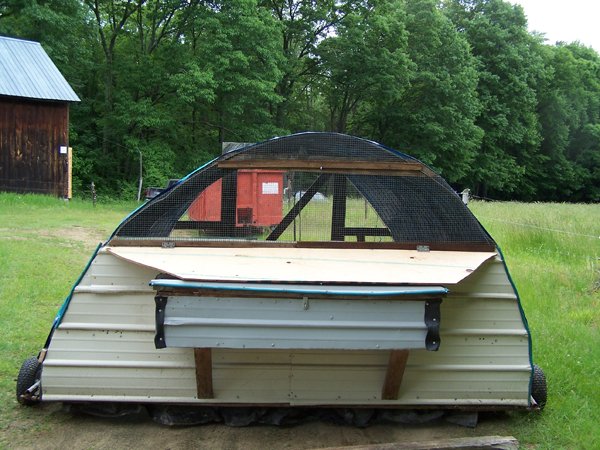
My husband went up to get the pasture coop repaired for this season Wednesday morning. When he went to put the (labeled) 12’ x 16’ tarp on, he discovered it was actually 12’ x 20’. Will have to buy a new one.

The support for the water reservoir had rotted out and he replaced that. It needed new tires and he only had 2, so he put those on. He’ll have to get 2 more.

We left a small vent when we built this coop 3 years ago. But it is just not enough and we decided to cut a bigger opening and put hardware cloth over it.

If it rains hard, he has designed a plywood door that we can close. It will lie on top of the nest boxes when open.

Right side finished, left still to do
The winter of 2017 – 2018 we left the tarp on. Big mistake, as it collapsed the coop. My husband was able to push it back up and hammer it more or less back in place (you may have noticed a list to the right…).
But what also happened when he did that was all the sharp wires holding the sections together were also pushed up. Last year they sawed holes all over the tarp and it disintegrated before the season ended.
So my job this morning at 6AM (before my helper friend arrived at 7:30) was to push them all back down, and to push down all the cut edges of the hardware cloth that was put on the back venting. I finished just before 7:30 only to be told my helper is sick and not coming.

My husband had gotten a new tarp the correct size so I proceeded to wire each grommet to the hardware cloth. This year we put the tarp up a good 6” above the bottom to allow more air flow.

But this meant when I got to the other side, I had no grommets to wire with. So we found a couple of pieces of 1” x 3” and wired them at the correct height to the hardware cloth and cattle panels. We folded the tarp under, wired the end grommets in place and screwed tobacco slats (what would we ever do without tobacco slats???) into the 1” x 3”.

He had to get 2 big hooks to close the rainguard and hold the nestbox cover open.

I put the feeder and waterer hangers up, and the stay for the door, so it can be left open. The nestboxes have to have a piece of plywood covering the opening so the chicks don’t sleep in them.
Once he gets new tires tomorrow, and the new netting arrives, we’ll put the chicks out, probably early next week.
The building of coops has been a constantly evolving thing since the first one in 2008. There’s been many changes and I’ve made posts about them:
The first, a Salatin pen:
https://steemit.com/homesteading/@goldenoakfarm/building-the-salatin-pen
The first pasture coop:
https://steemit.com/homesteading/@goldenoakfarm/building-the-pasture-coop
Building this hoophouse, in 3 parts:
https://steemit.com/homesteading/@goldenoakfarm/building-the-hoophouse-coop
https://steemit.com/homesteading/@goldenoakfarm/building-the-hoophouse-coop-part-2
https://steemit.com/homesteading/@goldenoakfarm/building-the-hoophouse-coop-part-3
And the new wheel system:
https://steemit.com/homesteading/@goldenoakfarm/new-wheel-system-for-moving-coops

Oh my. Such a high-tech, controlled process, this western way of wanna-be-natural chickens. If you saw how EASY it is here in Asia, the way chickens just free-roam (even on the streets) and integrate into every house and every farm, you might just laugh yourself stupid. :) A few lost here and there to eagles and dogs is considered a merit making karma gift and no one gets even remotely stressed about it. And eggs are CHEAP! 20 eggs cost me less than $1.
Leading the curation trail for both @ecotrain & @eco-alex.
Together We’re Making This World A Better Place.
Click Here To Join the manually curated trail "@artemislives" to support quality eco-green content.
@ecoTrain
Downvoting a post can decrease pending rewards and make it less visible. Common reasons:
Submit